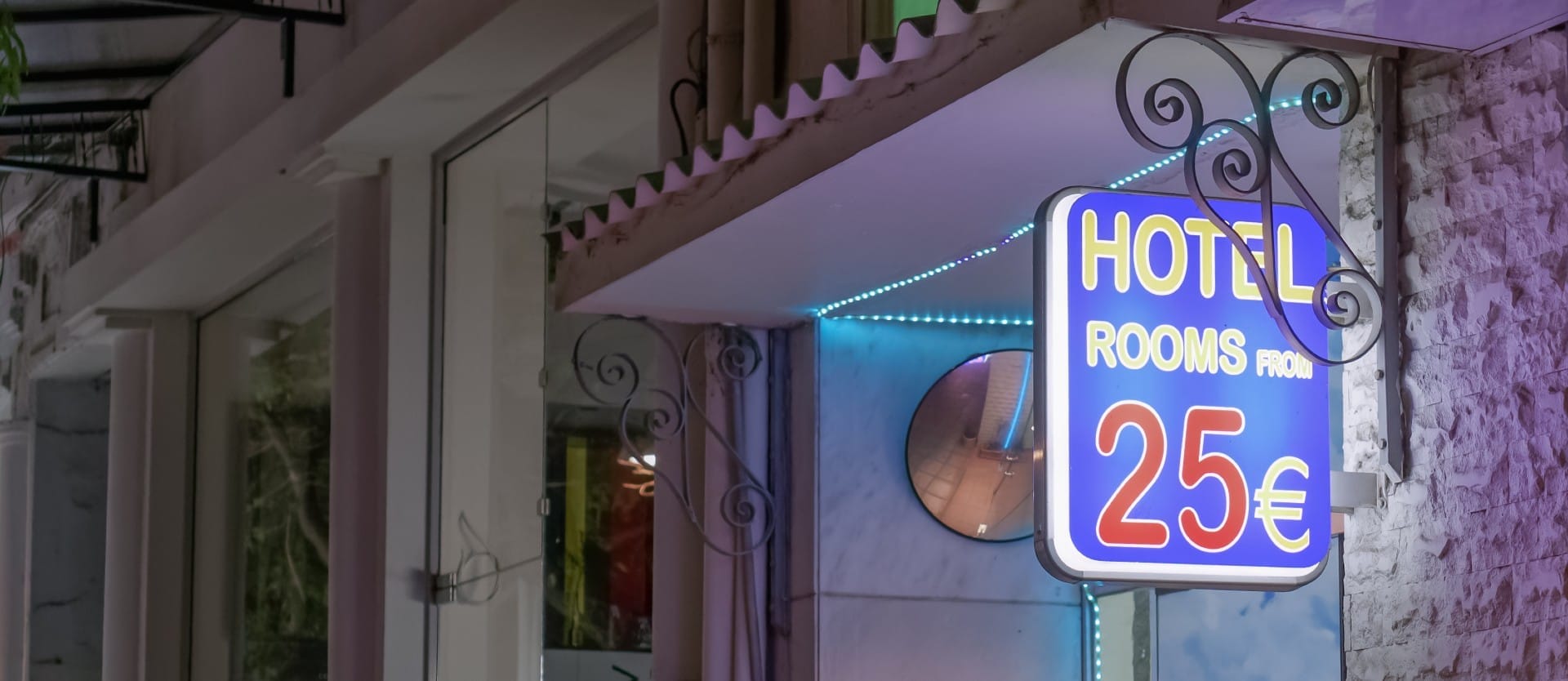Wondering about the maze of hotel rates — from the government to AAA, consortia, and industry rates — and how they are calculated? This article breaks down every type of hotel rate: base, discounted, negotiated rates, and others.
The guide provides insights to help you seamlessly navigate hotel pricing, negotiate contracts, or manage bookings.
Rack rate and BAR: the foundation of hotel pricing
A rack rate and best available rate (BAR) are the bedrocks of revenue management in hospitality—they shape guests' first impressions, with all other pricing structures built around them.
Today, these terms are often used interchangeably: In professional discussions and articles, BAR is sometimes referred to as 'rack rate'. However, we'll maintain a traditional approach and describe them separately, preserving the original meanings.
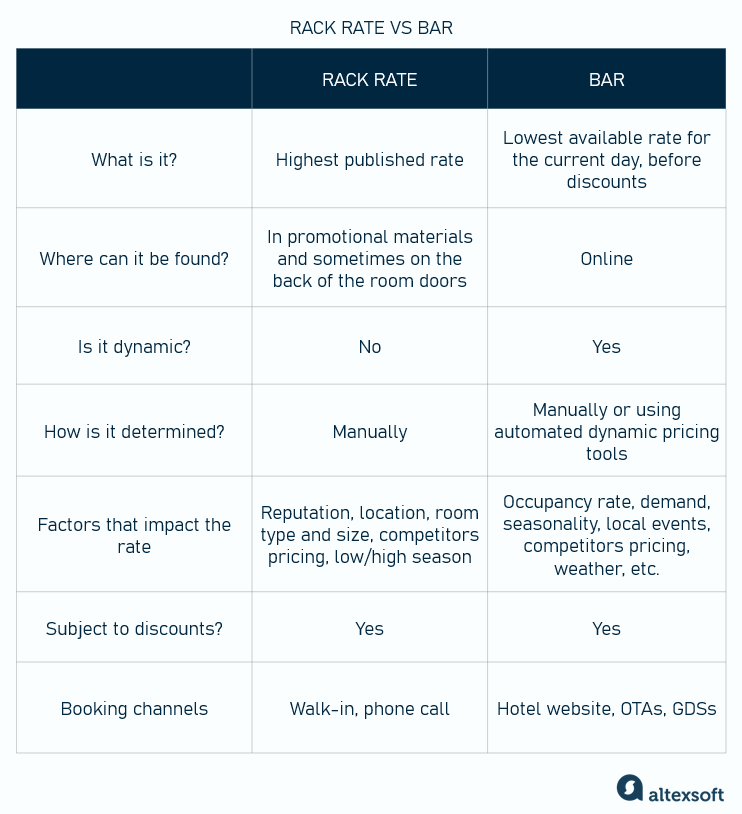
Rack rate vs BAR
What is a rack rate?
A rack rate, sometimes called a walk-in rate, is an officially published standard nightly rate for a specific room type without any discounts applied. It’s typically the highest price a guest is charged for a stay for this room type, with separate rack rates for low and high seasons.
This price can be found in brochures and promotional materials. The same amount will be quoted to a customer who simply walks in off the street and asks, “How much?”
However, in reality, the guest will pay this amount only under the most unfortunate of circumstances: Their flight has been canceled, it is nighttime, there is only one room left in the hotel, and all the other hotels are full because of an event going on in the city. If the situation is not that dramatic, the client will get one or another discount or simply book the same hotel via online travel agencies (OTAs), where the offer will be more attractive.
The term “rack rate” originated from the days when hotels displayed their room prices on metal or wooden racks at the reception desk. While this practice has long disappeared, in some countries, such as the UK and Italy, a law still obliges hoteliers to make their prices public and not to exceed them.
Historically, the mandatory publishing of the highest possible price aimed to protect guests from being overcharged by dishonest porters. In today's online booking and card payments world, the rule is outdated, to put it mildly. Nevertheless, the law is the law, and that’s why you can see the rack rates written on the backs of room doors in some localities.
Although the rack rate almost never reflects the actual price of a room, it has practical value because it serves as a point of reference for discounts, promotions, and contract negotiations. In addition, it provides a way to compare hotel categories at a glance. Luxury and budget hotels distinguish themselves through their rack rates.
How to calculate a rack rate
The most straightforward approach to calculating a rack rate is to add up spending per room per day and the desired profit. However, some hoteliers also consider the average occupancy, so the calculation can look like this.
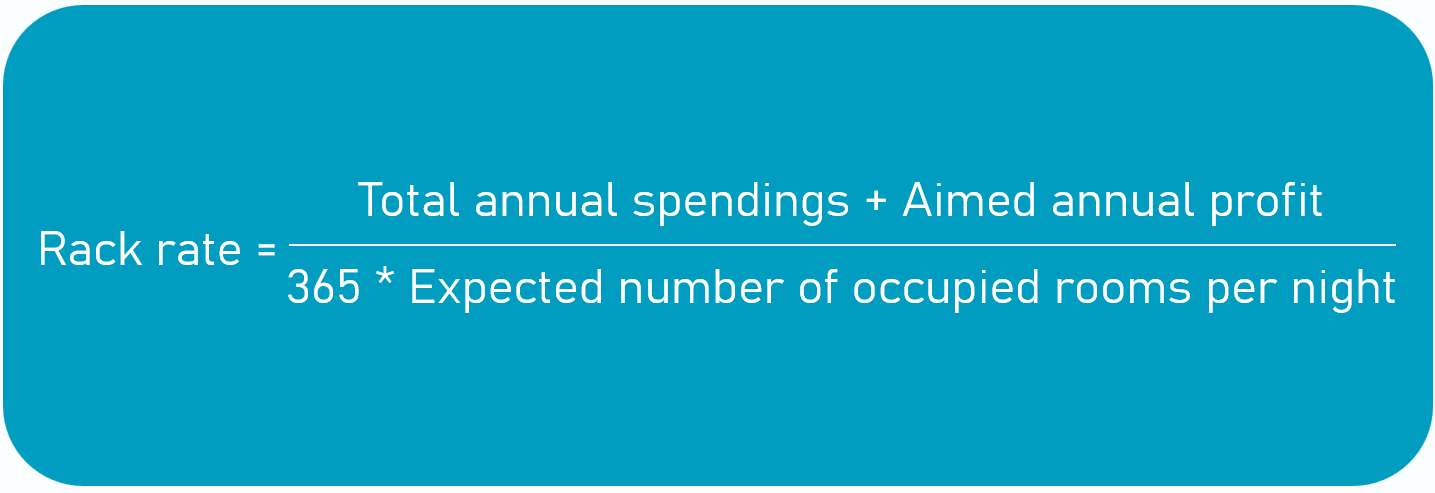
The calculation for rack rate can look like this
What does this formula show? An approximate amount is obtained by dividing the sum of total annual spending and a targeted yearly profit by 365 days and by the expected number of occupied rooms per night.
Here’s an illustration of a calculation for an imaginary Desert Rose Hotel with a four-star rating on the Spanish coast.
Annual expenditure breakdown:
- Construction and amortization: $100,000
- Operational costs including salaries, utilities & supplies, marketing, and others: $1,400,000
- Taxes and debt interest: $300,000
Total annual costs: $100.000+$1,400,000+$300,000=$1,800,000
Target profit: 20% of Total Annual Costs=$360,000
Expected number of occupied rooms per day: average occupancy rate (75 percent) * total number of rooms (100)=75.
Now, we apply the formula.
Rack rate: (1,800,000+360,000)/ (365*75)≈$79.00
But, again, this equation is only a guideline. Additional factors come into play.
Reputation and brand positioning. A five-star resort will never set prices that compete with budget accommodations, as this would undermine its brand identity.
Location. Just one example: Properties in Las Vegas within 0.72 miles of the Strip (part of the Boulevard South, the heart of the city's entertainment district) have a premium of 70 percent compared to hotels located beyond 2.25 miles.
Room size. Size is often considered while evaluating the rate for a particular room type. Let’s take two rooms with the same amenities, but one is 16 square meters, and another is 20. Guests can be charged more for the bigger one.
Competitive landscape. If nearby properties lower their rates due to low occupancy, a hotel may reduce its prices to stay competitive or keep its rate stable but include perks like complimentary breakfast or late checkout to justify the cost.
A rack rate often serves as a foundation for calculating another base price — best available rate.
What is BAR?
The best available rate (BAR), sometimes called the best flexible rate, refers to a hotel's lowest publicly available rate for a specific room type and particular date at a given time. It’s used as a baseline price to apply various pricing modifications depending on discounts, dates, demand, etc.
Like a rack rate, it doesn’t include any additional services, such as breakfast. Nor does it impose any requirements— e.g., corporate affiliation or full prepayment. It also has no rescheduling or cancellation penalties, provided booking changes adhere to the hotel's general policy (for instance, according to the policy, you must pay the equivalent of one night's stay if you cancel less than 24 hours before your scheduled check-in time).
In addition to leveraging BAR, hotels sometimes provide a Best Rate Guarantee (BRG), promising guests the lowest available rate when booking directly. If a client comes across a better price elsewhere for the same room type, dates, and booking conditions, the hotel reviews the claim and adjusts the booking to match that rate. The lucky low-rate catcher can also be offered additional perks.
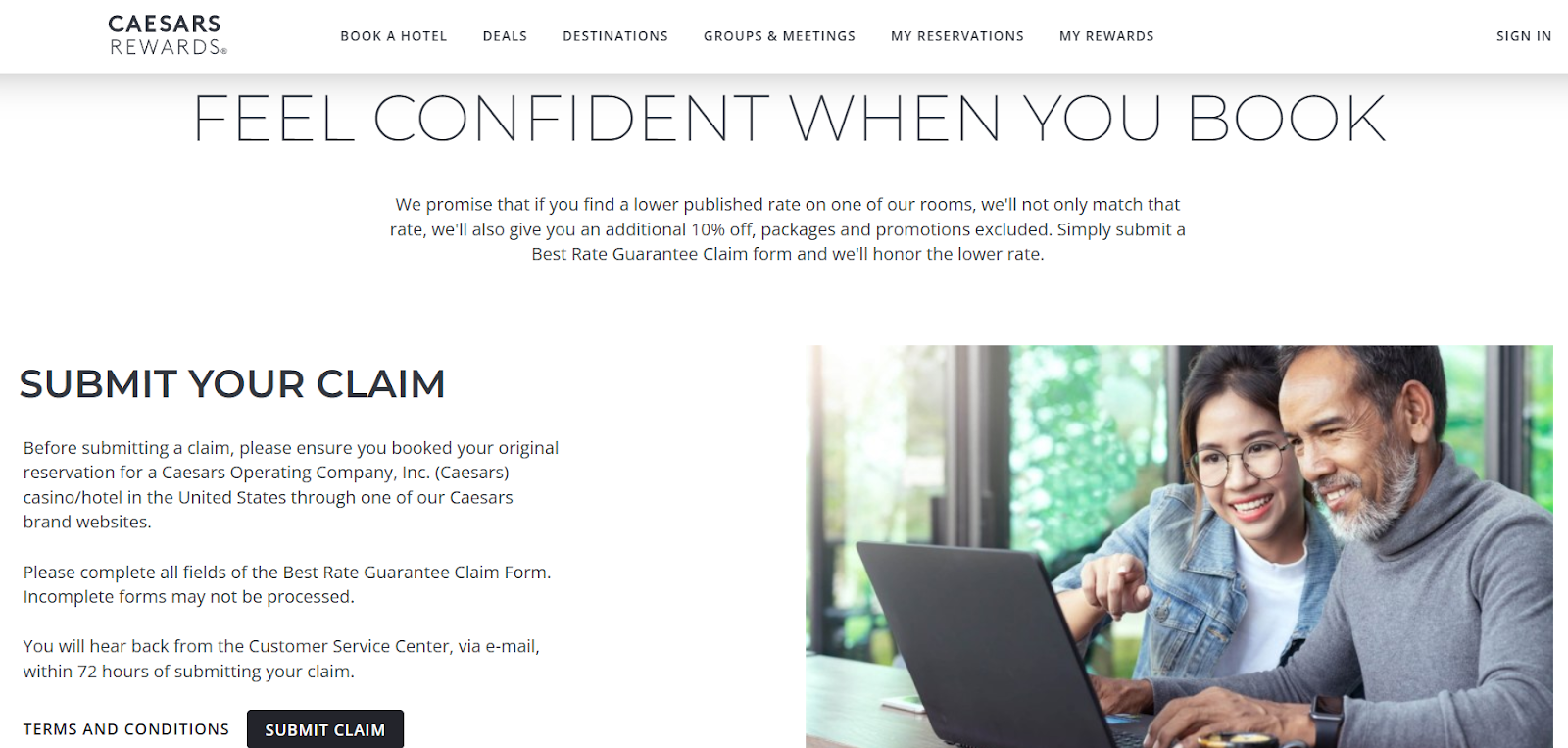
An online claim form for BRG on the Ceasar hotels website. Source: Caesars Rewards
It’s worth noting that the industry rule of rate parity in hospitality dictates maintaining the same price for the same room type across all public booking channels, such as the hotel's website, OTAs, and global distribution systems (GDSs). Considering this, the prices on the hotel website and most booking platforms will usually be the same.
However, some smaller OTAs tend to undercut prices to gain a competitive advantage, which creates a nuisance for hotels. By offering BRG, they not only increase guest confidence and encourage direct bookings but also get help finding rate parity violators.
How to calculate BAR?
As we said, BAR can be calculated from the rack rate considering various market conditions — such as current or expected occupancy rate, demand, seasonality, booking channel, competitors' behavior, and local events.
Say a traveler reserves a room at the Desert Rose Hotel in March for a stay in June at $100 per night. However, in April, a major travel magazine features the hotel as a "Top Summer Getaway," leading to a surge in bookings. By May, the same room may cost $130 per night.
Contrary to its name, BAR is not literally the lowest rate for a chosen room/day — as with a rack rate, various discounts can be applied to it.
Discounted rates
Accommodation providers leverage a range of perks and discounts to tempt potential guests. By the way, hotel managers openly admit that they tend to reward guests who are courteous to the staff with maximum discounts. Remember, politeness costs nothing but buys everything!
Package rates
These bundled rates include additional services or amenities like breakfast, spa access, parking, or event tickets. The total price is usually lower than booking each component separately.
Bed and breakfast (B&B) rate. Most hotels with in-house restaurants offer this rate. It’s especially convenient for business travelers and families who prefer not to search for a place to eat breakfast off premises.
All-inclusive rate. Another common package rate covers not just accommodation and meals but also drinks and often entertainment, activities, and airport transfers. This model simplifies guests' budgeting while maximizing on-property spending. All-inclusive rates are popular in resorts and vacation destinations.
For instance, Hilton All-Inclusive Resort and Vacation Hotels (15 properties in South Europe and Central America) offer a rate that includes all drinks and meals, on-site entertainment, fitness facilities, non-motorized aquatic sports, daily activities, free Wi-Fi, and all service fees and gratuities.

What’s included in the all-inclusive price? Source: Hilton.com
Other bundles can be, for example, a wellness or event package.
Promotional rates
Promotional rates are special discounted prices that are time-sensitive or offered for a limited period to help hotels boost occupancy or secure revenue. They may come with restrictions, such as non-refundable policies or minimum stay requirements, balancing guest incentives with revenue optimization.
Advance purchase/Early bird rate. A discounted rate for booking weeks or months (typically 30-120 days) beforehand is usually non-refundable. This condition solves one of the critical problems of hotel revenue management: People tend to cancel early reservations for various reasons. A non-refundable rate shifts financial responsibility to travelers, and the hotel is guaranteed revenue.
However, the staff should be prepared for the guests' dissatisfaction in case of cancellation because many people simply don’t notice terms written in fine print when booking.
Here, you can see the offer from Resident Hotels (the British collection of city center hotels). Terms and conditions include the rate being non-refundable and the hotel having the right to cancel the reservation due to a force majeure.
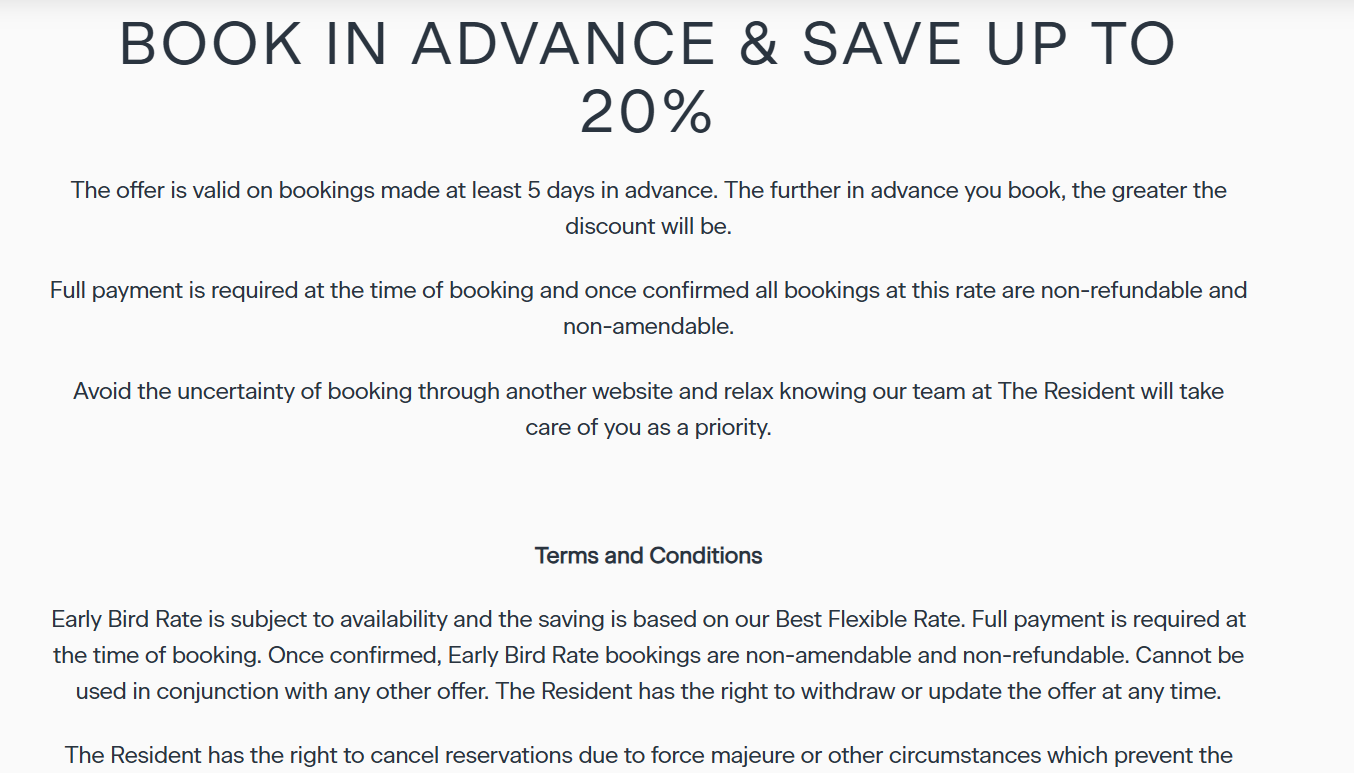
An example of an Early bird rate. Source: The Resident Hotels
Last-minute rate. A special rate for bookings made shortly before arrival helps boost revenue and fill unsold rooms. However, last-minute deals should be selective and limited. They can backfire if guests notice a pattern and delay booking to secure a lower price.
Flash sale. A temporary, steeply discounted rate is available for a very short period, offering potential guests a can’t-miss opportunity.
Here, you can see a flash sale announcement on the website of one of the largest world hotel groups, Wyndham Hotels&Resorts, in September 2024. The offer was valid for 10 days, from September 6 to September 16:

A flash sale announcement at the Wyndham Hotel&Resorts. Source: Wyndham Hotels
Qualified rates
This rate type applies to specific guest categories. Hotels rarely provide public information regarding the size of discounts, but most often, they do not exceed 10 percent of BAR and are based on room availability.
Member/loyalty rate. This rate is available to guests who join a hotel’s loyalty program or membership club. Perks may include late checkout, free parking, or free Wi-Fi.
A good example is Marriott International's loyalty program Marriott Bonvoy, offering members benefits such as discounted rates, free Wi-Fi, and the ability to earn points redeemable for free nights in over 7,000 hotels worldwide. The higher levels, besides other perks, enjoy free room upgrades, personal assistance, and flexible check-in/out.
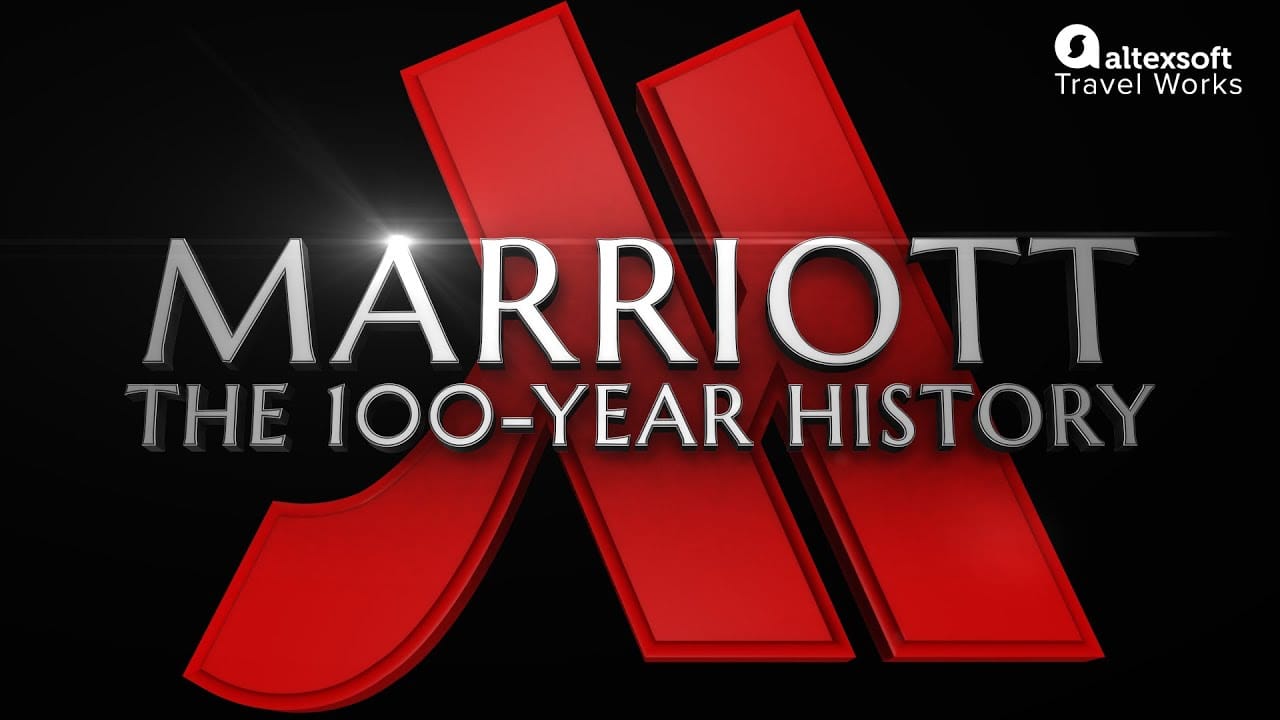

Group rate. This special offer is for a block of rooms booked together, usually for conferences, weddings, or business events. Discounts are based on the volume of rooms reserved.
Government rate. A rate for federal and/or state government employees traveling for official business requires valid government identification and may be subject to eligibility rules. Hotels often set this rate at or above the official per diem rates— daily allowance for expenses like lodging and meals during business trips recommended or dictated by government bodies.
The US federal government per diem rates are established by the US General Service Administration. In California, the numbers vary from $131 (Tahoe City) to $273 (Santa Monica) for lodging remuneration. Meals and incidental expense rates in the same state add $68-92 to the daily allowance. For comparison, the European Commission establishes per diem rates at $377 for an employee’s trip to the United States, $179 for Lithuania, $311 for Denmark, and $467 for the Virgin Islands.
Military rate. This is a discounted rate for active-duty military personnel traveling for official business. Proof of military service is typically required at check-in. Some properties also have a special rate for leisure travel for active duty and veterans, and sometimes military families.
For example, Choice Hotels offers special limited-time Gold Elite status and exclusive rates to active-duty military members, veterans, and military spouses. IHG Hotels&Resorts also welcomes active and veteran military members with discounts on BAR starting at 5 percent.
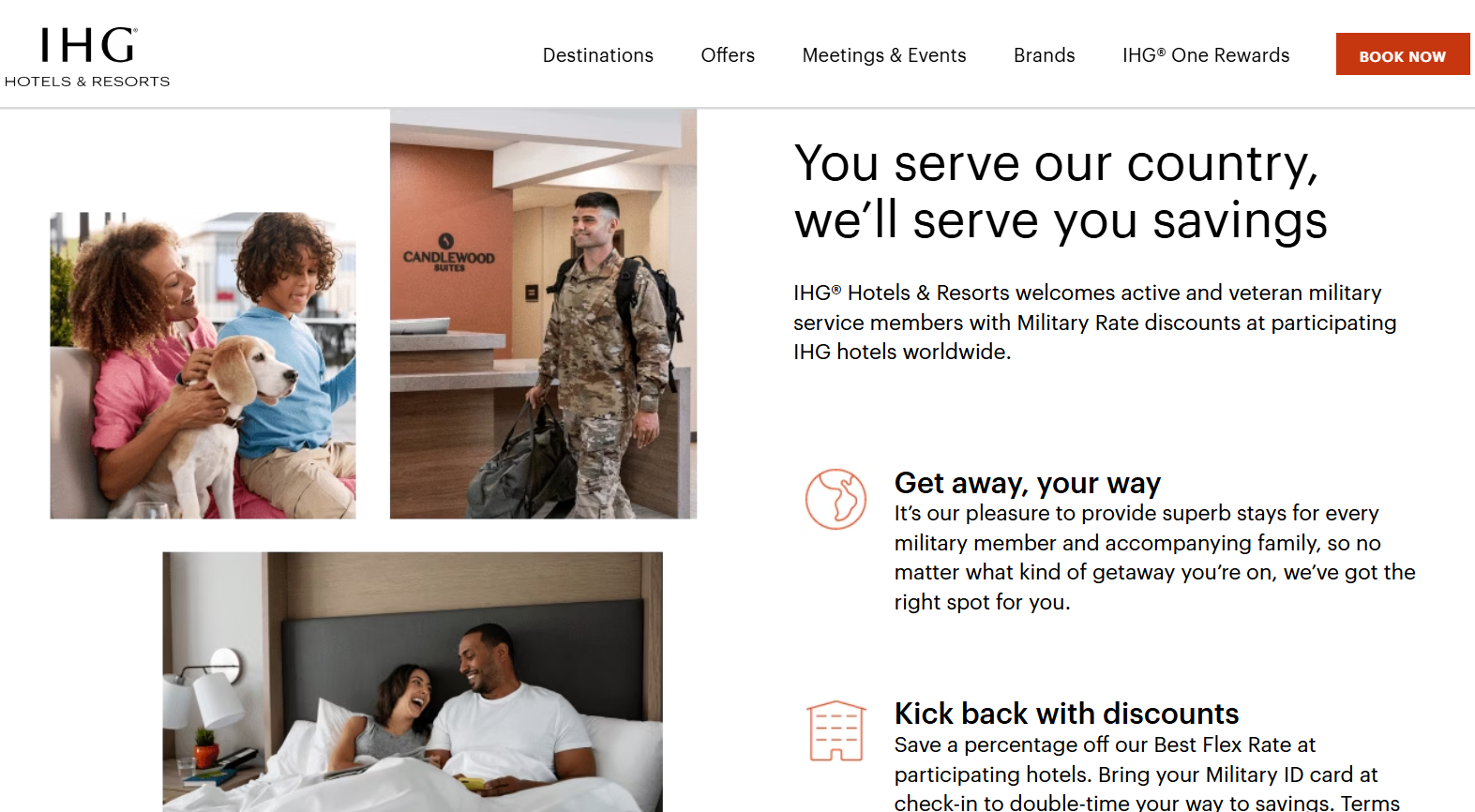
A military rate program at IHG Hotels&Resorts. Source: IHG Hotels & Resorts
AAA rate. Members of the American Automobile Association (AAA) can get special, up to 10 percent, discounts from partner hotel brands including Marriott, Hilton, Hyatt, and Choice. A 16-digit AAA member ID must be presented to qualify.
This rate type is valid only for the US. Still, major hotel chains worldwide may offer discounts for automobile association members regardless of country, especially if the local association is a member of an international association (e.g., Federation Internationale de l'Automobile, or FIA).
AARP rate. Members of the American Association of Retired Persons (AARP) can expect a discounted rate too. Membership cards must be presented to qualify.
Employee/Industry rate. Hotels usually offer discounts to not only their employees, but other's too. Special programs, like Hotel Employee Rates, connect accommodation providers worldwide, slashing prices for hospitality workers at any participating property as long as their employer is a program member. Markdowns typically range from 40 to 50 percent, depending on the hotel's star rating.
This is similar to airline agreements: Pilots can fly free on partner airlines in a folding seat in the cockpit.
Day use rates
Hotels take every opportunity to maximize revenue, such as renting out conference rooms for official events or banquet halls for weddings and anniversaries. In recent years, renting out rooms during the day has become increasingly popular.
Day use rates are meant for short stays during daytime hours without sleeping overnight. For instance, countryside hotels can offer this rate for those who want to spend a day in nature or near a pool. Also, some airport hotels offer a reduced day rate for corporate customers.
Some booking platforms, like Dayuse and Dayrooms, have made day rates their specialty. They partner with major hotel brands and advertise prices up to 75 percent lower than overnight stays.
Opaque rates
Opaque rates are significantly reduced rates at a hotel that remains unknown until after booking. Travelers make their choice based on the location, star rating, and amenities.
Such hidden deals can be found on specialized travel platforms like Priceline and Hotwire. They source rooms from bed banks or partner directly with hotels that provide exclusive discounts on distressed inventory—rooms that haven’t been sold and might otherwise remain empty. This way, they fill the property without breaking rate parity.
B2B or contract rates
To maximize inventory sales and revenue, hotels leverage multiple distribution channels, including OTAs, traditional travel agents, travel management companies (TMCs), destination management companies (DMCs), and tour operators.
Special rates are used when partnering with these platforms and organizations.
Net rate
A net rate, also known as a travel agent rate, is the pre-commission price hotels offer to resellers. It’s a discounted rate that allows agencies to mark up the price before selling rooms to travelers as standalone rooms or packaged deals.
Net rates are usually pre-negotiated, fixed, and not subject to changes. They are valid only for travel agencies that are registered merchants of record and can accept customer payments. If resellers operate under an agency model and can’t mark up prices, they sell inventory to travelers at the standard rate (BAR) and then get a commission for each booking.
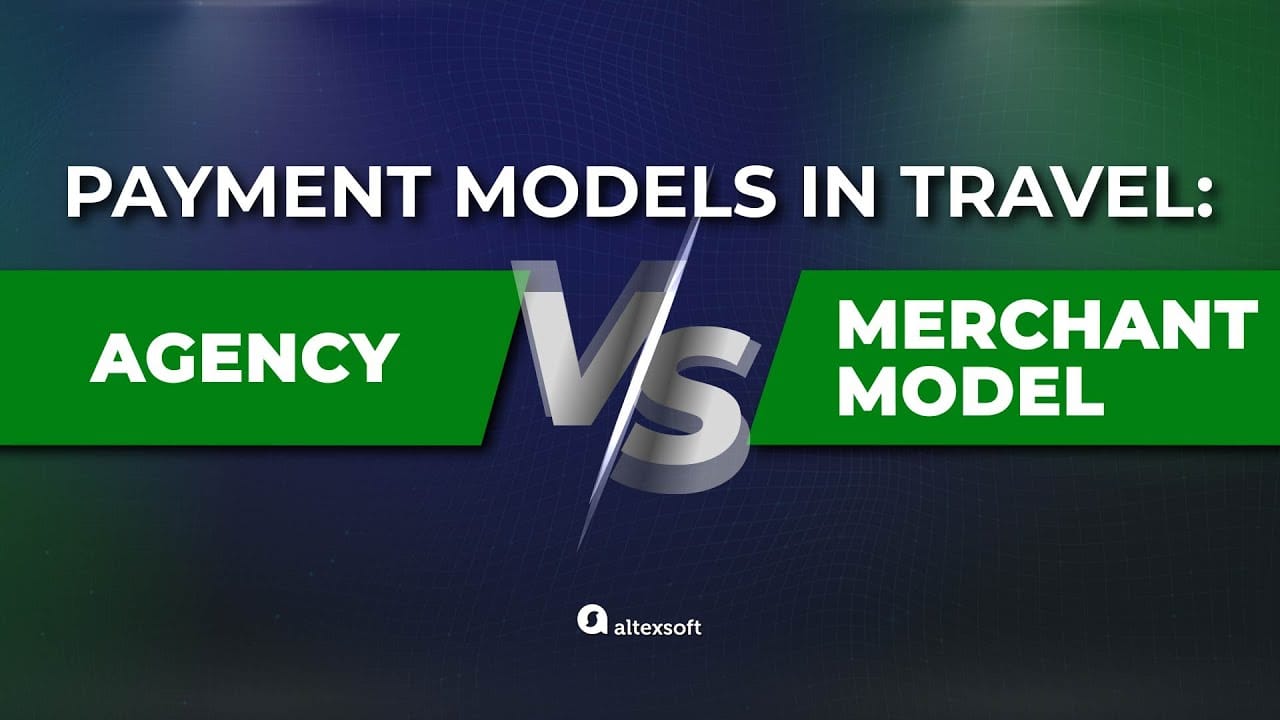

Wholesaler rates
Wholesaler rates are deeply discounted prices that hotels offer to wholesalers, also known as bed banks. Negotiated for bulk orders, these rates are typically lower than net ones. Even after a bed bank marks them up and distributes them to various booking channels, the prices are still lower than published ones. So travel resellers partnering with bed banks (among which are OTAs, tour operators, travel aggregator platforms, and even airlines) still have room to get a good margin and stay competitive.
Wholesalers often go beyond simply selling hotel rooms—they bundle accommodations with additional services like flights, transfers, meals, car rentals, and tours.
Corporate rates
Corporate rates are set by contracts with organizations that frequently book rooms for their employees with a particular hotel or hotel chain and ensure consistent revenue for the supplier. Besides bargain prices, the contract may offer favorable conditions like flexible rebooking and cancelation since business travel plans often change at short notice.
The final terms here largely depend on the booking volumes: The more an organization buys from a particular service provider, the better the negotiated rates are. Large companies can account for 20-30 percent discounts on rack rates for their corporate travel programs.


Consortia/TMC rates
Unlike corporate rates set for a particular company, consortia rates are negotiated by large travel management companies (TMCs) and groups of businesses (host agencies, trip advisors, OTAs, smaller TMCs, etc) united in consortia to obtain better conditions. Some examples are ABC Global Services, CCRA, and THOR. Consortia/TMC rates are available on GDSs, but only affiliated agents can view and book them.
Hotels join consortium programs to boost their visibility and generate additional sales, especially among corporate customers who book their business trips exclusively via GDSs. Yet, accommodation providers must meet certain requirements to participate including:
- a 10 percent commission for agents;
- a 10-percent minimum discount on the lowest published rate;
- last room availability guarantee; and
- rate parity among programs.
Also, hotels must factor in expenses on GDS connections—such as listing fees, transaction fees, advertising payments, etc.
Static vs dynamic rates
All prices discussed so far can be divided into two big groups: static and dynamic. A rack rate and all cheaper deals derived from it are static. But if you apply discounts to BAR, you’re on the dynamic side of things.
With the rise of online distribution and price transparency, static hotel pricing has lost its economic effectiveness. In the late 1980s, Marriott pioneered dynamic pricing for B2C sales, and other major brands followed suit in the 1990s. The B2B sector remained static for longer, but in 2004 Hilton Hotels Corp. and InterContinental were the first to replace fixed consortia rates with more flexible pricing.
The hotel dynamic pricing approach allows suppliers to capture the highest possible value at any point in time. The goal is to find an equilibrium price where supply meets demand, ensuring that both the service provider and the customer perceive the rate as fair at a given moment and under certain circumstances.
For instance, family suites and rooms with a view surge in value during holidays, while single rooms are more popular on weekdays. Unexpected spikes occur due to weather disruptions or airport delays, creating last-minute booking opportunities. And don’t forget peak seasons: In Sanya (China), rates increase 160 percent during Chinese New Year compared to the off-season.
There are two main dynamic pricing strategies: BAR-based and open pricing. Both approaches consider market conditions such as demand, seasonality, and special events, but they differ in flexibility, frequency of change, and complexity.
BAR-based strategy
As we said, BAR is a flexible rate adjusted to market conditions. Theoretically, it can be changed daily and react on the slightest variations in demand, but such agility is hard to achieve without a modern revenue management system and other technologies in place.
Since many hotels still set their prices manually, they only leverage a limited number of BARs choosing among three or four base rates.
Say a standard double in our imaginary Desert Rose Hotel on the Spanish coast might have three BARs for a high season:
- BAR 1 ($120) for weekdays
- BAR 2 ($170) for weekends and holidays
- BAR 3 ($230) for special events (festivals, concerts)
There can be more BAR tiers, and besides, hoteliers would apply to each of them predefined modifiers — for example, a $50 surcharge for an ocean-view room, a 20 percent corporate discount, and 15 percent for Agoda bookings. Potentially, coefficients can be created to account for dozens of different circumstances and conditions.
So, the goal is partly achieved— rates vary according to demand and allow for a balance of income. However, hoteliers are still restricted to a set number of BAR tiers and fixed modifiers that are not inherently dynamic. A more modern approach— open pricing — takes the concept a step further.
Open pricing
Open pricing allows hotels to adjust the price of each room, package, or service separately, and discounts can also vary widely, say from 5 percent to 80 percent, depending on demand and readiness to pay. If guests are not prepared to book at $75 per night, why not offer $70 or $65? And if demand is at a standstill, selling suites at $50 per night might be better than leaving them empty.
This approach also allows for personalized pricing. For example, a business traveler might qualify for a corporate rate, but offering an extra discount could strengthen loyalty if it's his third stay.
Such flexibility maximizes occupancy and captures additional revenue whenever possible. On the other hand, implementing dynamic pricing at this level of flexibility and granularity can be extremely challenging. The technology behind it leverages advanced data analytics and machine learning algorithms to process vast amounts of information, including historical booking patterns, competitor pricing, and external events that may influence demand.
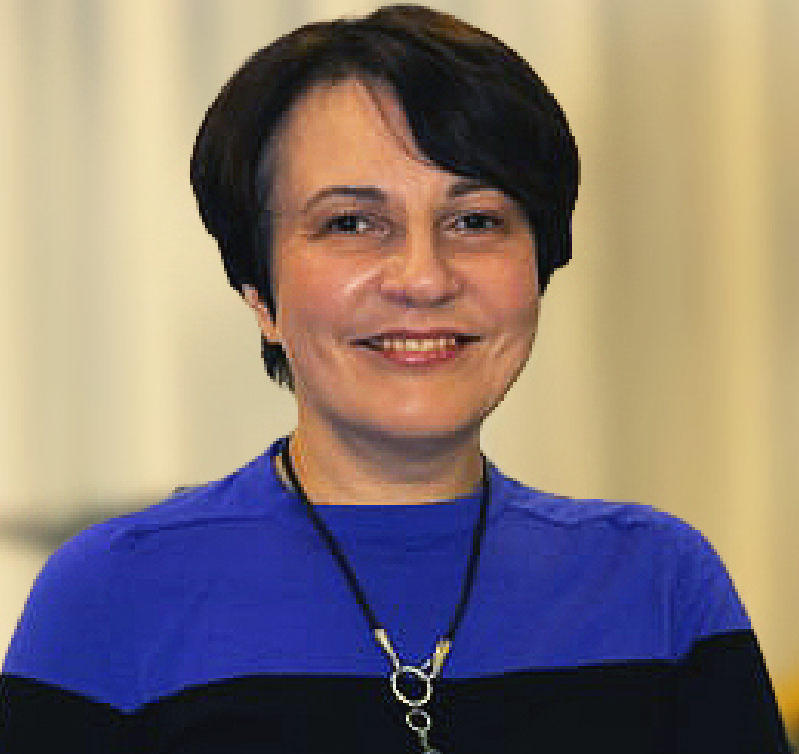
Olga is a tech journalist at AltexSoft, specializing in travel technologies. With over 25 years of experience in journalism, she began her career writing travel articles for glossy magazines before advancing to editor-in-chief of a specialized media outlet focused on science and travel. Her diverse background also includes roles as a QA specialist and tech writer.
Want to write an article for our blog? Read our requirements and guidelines to become a contributor.
